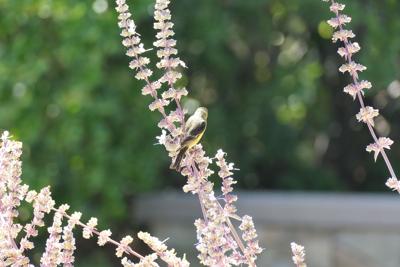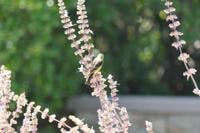White sage, a water-wise, California native pollinator magnet, is being unlawfully poached from the state’s wildlands, warns the Orange County chapter of the California Native Plant Society (OCCNPS).
According to the group, the white sage is dried and then sold for burning practices.
To raise awareness of the illegal harvesting of wild white sage from protected lands and encourage locals to grow the native plant, the Plant Society has launched the “Sage in Every Garden” campaign, giving away four-inch white sage plants to Orange County residents.
For the campaign, OCCNPS partnered with the Tree of Life Nursery in San Juan Capistrano. The nursery cultivated white sage plants for the Plant Society to distribute at various community events, encouraging residents to grow the plant in their own gardens.
The Plant Society will host an event at the Dana Point Nature Interpretive Center on Saturday, Jan. 21, giving away one free white sage plant per Orange County resident, while supplies last.
The California native plant is also easy to care for, said Elizabeth Wallace, OCCNPS board member and author of the blog “Buckwheat Brings Butterflies.” At each event, the Plant Society will hand out care sheets with each white sage it gives away.
“When you first plant a white sage, you need to water it really deeply. And then, after the plant is established after it doubles in size, you can reduce the watering,” Wallace said, adding: “Then, once that white sage is growing in your garden, you really never have to water it again. You just rely on winter rains to water it.”
White sage, also known as Salvia Apiana, needs very little water and supports birds and pollinators.
“Salvia Apiana—Apiana means it’s good for bees—it’s an important plant for pollinators and birds,” Wallace said. “It’s beautiful, too.”
“I consider white sage to be an accent plant, because it can grow to about 3 feet wide and tall,” Wallace continued. “I like to install it in landscapes, as it’s really a showy kind of plant.”
The OCCNPS warns against buying “wild-sourced” white sage products such as smudge bundles, incense or oils, as these are often made from poached plants.
“The problem is that white sage only grows in Southern California and Northern Baja, Mexico, and people are stealing it out of the wild,” Wallace said. “They’re removing it, pulling it up by the roots from our wild lands, so this is harming our natural environment.”
California State Parks prohibits the removal of any portion of plants, including leaves and shrubs, from parklands except when specifically authorized.
Wallace added that television and social media have popularized the burning of white sage. Not only is the illegal poaching of wild white sage a concern, Wallace added that the use of white sage could also be considered cultural appropriation.
Jerry Nieblas, a descendent of the Acjachemen Indigenous people in San Juan Capistrano, emphasized white sage’s importance in his culture.
“It’s been important to us for all times. It’s used in our ceremonies, it’s used for blessings, on special occasions; it’s used for sacred ceremonies. We use it when we bury our dead, we use it when we unite people, we use it to cleanse before meetings,” Nieblas said, adding: “It’s very much a part of our life, but it’s a symbol that’s very sacred, very important.”
The process of gathering, drying and wrapping the sage is vitally important in the cultivation of sage, Nieblas said, with the dried leaves ceremoniously wrapped in colorful yarns.
With the increase in commercial cultivation and poaching of white sage, with many poachers cutting the plants down so far that they don’t grow back, Nieblas commented that he and his family have cut back on their own use of sage.
“What I find myself doing is thinking twice before I gather, being very cautious, what I’m gathering and the amounts I’m gathering, when before it was so plentiful,” Nieblas said. “It was just thought that our people were using it and other Native American communities were using it.”
Nieblas urges those who are interested in the practice of burning sage, but who are not Native American, to stop and take time to meet with tribal members in their area to learn more about the practice.
“I’d be honored, and I’d be willing to talk to people, non-native, who think it’s OK to use sage just as anything,” he said, further encouraging people to “talk to us, learn about the sage and what it means to us in our ceremonies, in our people, in our cleansing, in our spiritual life. Learn from us. Learn what it means, the importance to our tribal community and how vital it has been to us since forever.”
The California Native Plant Society launched the “Sage in Every Garden” campaign to raise awareness to the impact commercial cultivation and poaching of white sage has had on the state’s population of wild sage.
“The main reason we’re doing this campaign is to try to raise awareness about how white sage is being poached and how we shouldn’t buy smudge bundles at stores, because they probably aren’t legally collected,” Wallace continued.
The Gabrieleno (Tongva) Band of Mission Indians website also warns that certain retailers “all sell ‘wild gathered’ sage, without specifying how their sage is gathered.”
White sage bundles advertised as “foraged” are often unlawfully cultivated, OCCNPS warns.
The group will give away 192 white sage plants at two concurrent events in North and South Orange County next weekend. The Plant Society will give away 96 plants at the Home Grown Farmers Market in Orange and another 96 at the Dana Point Headlands event.
More information can be found at the Plant Society’s website or at buckwheatbringsbutterflies.com. The Dana Point Nature Interpretive Center is located at 34558 Scenic Drive, Dana Point Headlands.


